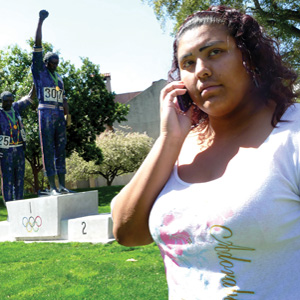Twenty-year-old Sandra Huerta proudly talks about being the first member of her family to go to college. The Hayward High School graduate says AP English and history classes got her thinking about college, and lured her away from gangs and drugs.
The statue of Olympians Tommy Smith and John Carlos, which she saw on a visit to San Jose State University, inspired her to enroll there as a sociology major with a concentration in community change.
A scholarship got her a free freshman year, with dorm and books included. But decreases in financial aid sent her back home for her sophomore and junior years, to free room and board, a part-time job so she could pay for books and tuition—and a long BART and bus commute.
Huerta’s hard work is paying off; she is a Dean’s Scholar. But she worries that more budget cuts could prevent her from graduating next year, which could keep her from her dream of earning a Ph.D. and becoming a college professor.
Last week, the California State University system’s trustees met to review strategies for addressing what will be the largest funding gap in its history, assuming that the 2011-2012 budget will include $500 million in cuts that the governor proposed in January.
That would give CSU schools 18 percent less money to work with than they had in 2010-2011.
Across the system, campuses will be asked to reduce their budgets by $281 million and to turn away 10,000 new students in order to save another $60 million.
But that’s not the worst-case scenario. If tax extensions backed by the governor don’t reach the June ballot and aren’t approved by voters, CSU could face a $1 billion reduction in state funding.
That would have an enormous impact on a generation of young Californians: CSU is the largest system of higher education in the country, with more than 410,000 students at 23 campuses, and awards about 90,000 degrees annually.
San Jose State University is one of the CSU’s largest campuses, and with about 30,000 students it’s the largest supplier of engineering, education, computer science and business degrees in Silicon Valley.
SJSU spokesperson Pat Lopes says the university has successfully weathered severe budget cuts since the state’s revenues started tanking in 2008 by reducing enrollment, laying off workers and implementing staff furloughs.
“The proposed cuts are huge but SJSU has prepared well and we’re in good shape for fall 2011,” Lopes says. “When the CSU system talks about reducing enrollment, it’s really important to remember that it won’t affect any student who’s currently here.”
The cuts to enrollment will come in spring 2012. But currently enrolled students will likely be impacted if the university is forced to reduce the number of courses and sections it offers.
“So it will be harder to get classes,” Lopes concedes. “If we face a $1 billion cut, students face tuition increases and perhaps a reduction in courses and sections. That’s really important to them. The number-one search term on the SJSU website is ‘tuition.’”
Bye-Bye Four-Year Plan
Huerta, who maintains a 3.7 grade-point average, says she’s felt budget pinches since her freshman year. Fewer sections of general education classes sent her to community college to get the classes she needed to stay on track for graduation.
“They tell you that you can graduate in four years,” she says, “but because it’s so expensive and not all classes are offered each semester it takes most students much longer.”
“I have friends right now who have been at State for eight years trying to graduate because they can’t get the classes they need,” she says. “And they have to work more to pay for books and tuition increases.
“If the classes I need aren’t offered when I need them I’ll have to postpone my graduation.”
Lindsey Leong, 26, transferred from San Jose City College two years ago and will graduate from SJSU this June.
She says that last year, half of the classes she needed to get her degree weren’t offered so she got her academic advisor to sign off on substitute classes counting toward her major.
“I know other graduating seniors who were waitlisted because of the budget crisis and got no classes they needed,” Leong says. “They took one irrelevant class just so they could stay enrolled.”
Leong says SJSU could do more to mitigate the adverse impacts of fewer classes by fixing weak academic counseling services.
“They aren’t offering enough sections of classes, they’re limiting the numbers of students in classes and they aren’t adequately counseling students as to how to meet graduation requirements,” she says, adding that SJSU needs to improve its support for students so they know how to graduate.
Leong says there is no one place where a student can find basic information about meeting graduation requirements, and that different advisors give conflicting advice. “There’s got to be consistency and support so students know what to do so they can graduate on time,” she says,Huerta agrees that it’s getting more difficult to get a degree at SJSU. “Every time they increase tuition and offer fewer sections, students have to drop out,” she says. “It’s usually working class and people of color. But now that it’s affecting students who are higher up on the social ladder they’re calling this a crisis.”

 City Council Passes Dog Leash Ordinance
City Council Passes Dog Leash Ordinance  San Jose Makes Power Play for A’s Baseball Stadium
San Jose Makes Power Play for A’s Baseball Stadium 